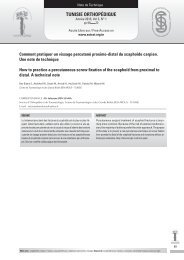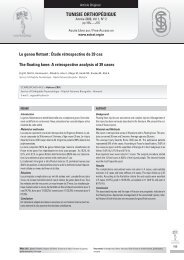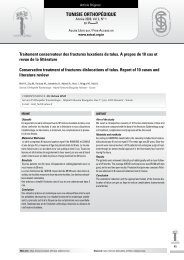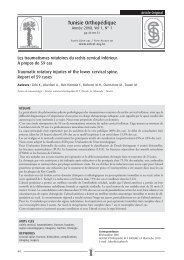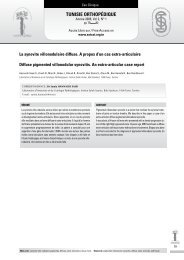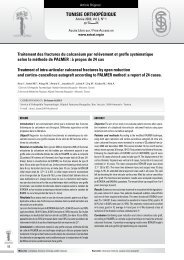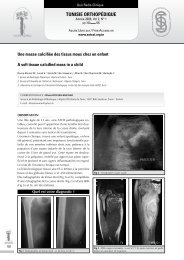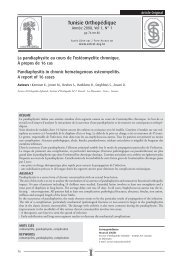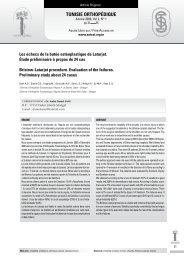Robert», la partie de l'art médical qui a pour objet - sotcot
Robert», la partie de l'art médical qui a pour objet - sotcot
Robert», la partie de l'art médical qui a pour objet - sotcot
You also want an ePaper? Increase the reach of your titles
YUMPU automatically turns print PDFs into web optimized ePapers that Google loves.
Tun Orthop 2008, Vol 1, N° 2Articles ImmigrésresultsSpinal curves clinical measurement and the swayvelocity of the pressure center on the Ba<strong>la</strong>nce MasterNeurocom do not show significant differencebetween the two groups. While the pressure centerposition in the anteroposterior axis shows significantdifference between the two groups (p=0.02)with a more backwards projection found in chroniclow back pain subjects. Radiological evaluationshows sagittal shelter significantly superior,sacral slope significantly lower and the type 1 oflumbar lordosis more frequent in chronic low backpain women compared to healthy women.discussion-conclusionIn menopausal women, chronic low back painseems to be associated with lower sacal slope,the type 1 of lumbar lordosis more frequent andbehindly projection of pressure center.one patient (2 hips). Coxa vara recurred in 7 hips.In 4 of these hips, repeat surgery with hypervalgusosteotomy was indicated to stop epiphysealslipping (3 hips) or to improve the arc of motion(1 hip). Functional outcomes were poor in coxavara associated with poor epiphyseal <strong>de</strong>velopment(nonossified or fragmented epiphysis) as seen inspondyloepiphyseal dysp<strong>la</strong>sia congenita, spondyloepimetaphysealdysp<strong>la</strong>sia, Kniest disease, andmultiple epiphyseal dysp<strong>la</strong>sia. Coxa vara with physealinstability as observed in spondylometaphysealdysp<strong>la</strong>sia resulted in <strong>de</strong>formity recurrence postoperativelyduring growth. In contrast, outcomewas better in cases of coxa vara with nonphyseal/nonepiphyseal involvement, that is, good femoralhead morphology, stable physis, and good articu<strong>la</strong>rcarti<strong>la</strong>ge, as seen in cases of metaphyseal dysp<strong>la</strong>siaand cleidocranial dysp<strong>la</strong>sia.Conclusions8- coxa vara in chondrodysp<strong>la</strong>sia: prognosisstudy of 35 hips in 19 childrenTrigui M, Pannier S, Finidori G, Padovani JP, Glorion C.Department of Orthopaedic Surgery, Habib Bourguiba Hospital, Sfax, Tunisia.dr_moez_trigui@yahoo.frJ Pediatr Orthop. 2008 Sep;28(6):599-606.BackgroundTo better un<strong>de</strong>rstand anatomical and functionaloutcomes of coxa vara in chondrodysp<strong>la</strong>sia accordingto the initial presenting hip morphology,disease type, and impact of surgery.Coxa vara with physeal and epiphyseal involvementand severe impairment of the articu<strong>la</strong>rcarti<strong>la</strong>ge has a poor prognosis even after reconstructivesurgery. In coxa vara with an abnormalphysis, there were numerous postsurgical recurrencesof the <strong>de</strong>formity during growth if the physiswas not stabilized at the time of valgus osteotomy.In these cases, we should <strong>de</strong><strong>la</strong>y osteotomy unti<strong>la</strong>n HEA greater than 60 <strong>de</strong>grees. Coxa vara inwhich only the metaphysis of the femoral neckis involved, the <strong>de</strong>formity is mil<strong>de</strong>r and often re<strong>qui</strong>resno treatment. Indications for surgery in thisgroup are increasing coxa vara, Tren<strong>de</strong>lenburggait, or an HEA greater than 60 <strong>de</strong>grees.216methodsClinical and radiographic records of 19 children(35 hips) diagnosed with coxa vara and with osteochondrodysp<strong>la</strong>siawere reviewed. We c<strong>la</strong>ssified thehip radiographic findings into 2 groups: (a) groupI, coxa vara with a fragmented and/or nonossifiedhead; and (b) group II, coxa vara with a regu<strong>la</strong>rfemoral head. Surgical indications in coxa varainclu<strong>de</strong>d <strong>de</strong>creased range of hip motion (usuallydiminished abduction, extension, and internal rotation),coxa vara with progression documented onregu<strong>la</strong>r follow-up hip radiographs, and/or severecoxa vara with a Hilgenreiner epiphyseal angle(HEA) of 60 <strong>de</strong>grees or more. Follow-up was untilthe completion of growth and, for some patients,into early adulthood. Mean follow-up was 8 years.resultsTwenty-five hips were operated on in 13 patients.In 23 hips, the procedure was a valgus osteotomyfixed by pins and wire. A pelvic extension osteotomywithout valgus osteotomy was performed in9- Association of spinal <strong>de</strong>formities withheavy metal bioaccumu<strong>la</strong>tion in naturalpopu<strong>la</strong>tions of grass goby, Zosterisessorophiocephalus pal<strong>la</strong>s, 1811 from the Gulfof Gabès (Tunisia)Messaoudi I, Deli T, Kessabi K, Barhoumi S, Kerkeni A, Saïd K.UR 09/30: Génétique, Biodiversité et Valorisation <strong>de</strong>s Bioressources,Institut Supérieur <strong>de</strong> Biotechnologie, 5000, Monastir, Tunisia, imed_messaoudi@yahoo.fr.Environ Monit Assess. 2008 Aug 16.The present study illustrates an analysis of spinal<strong>de</strong>formities associated with metal accumu<strong>la</strong>tion innatural popu<strong>la</strong>tions of Zosterisessor ophiocephalus<strong>de</strong>rived from polluted (S1) and unpolluted(S2) areas in the Gulf of Gabès in Tunisia. Threebasic types of spinal <strong>de</strong>formities were <strong>de</strong>tected:kyphosis, scoliosis and lordosis. These basic <strong>de</strong>formitiesfrequently co-occur. Spinal <strong>de</strong>formitieswere observed in 10.72% of the total examinedfish (n = 494). Deformed fish were 3.85 times



